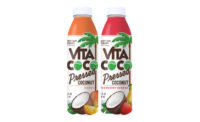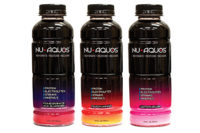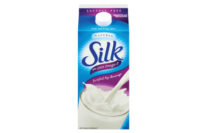Beverages have become more than just a source of refreshment. Consumers also are turning to beverages for functional benefits. Sports drinks as well as energy drinks and shots have become a source to provide a variety of functionalities.
“There are quite a number of functional benefits that consumers are looking for with energy drinks and shots besides [an energy] boost,” says Garima Goel Lal, senior analyst at Mintel International, Chicago.
Goel Lal says the top three reasons that people consume energy drinks are for an energy boost, mental alertness and to stay awake. She says that 68 percent of all energy drink users say they drink energy drinks for an energy boost, with 21 percent saying they use them for relaxation. Other functions are hydration at 25 percent, health and nutrition at 19 percent, and weight management at 17 percent, she adds.
With energy being so important for consumers, it also is a popular health position for beverages. Energy/alertness made up 71 percent of global energy and sports drinks product launches tracked from the first half of 2010 to the first half of 2011, according to Innova Market Insights, Duiven, The Netherlands. Next was sports and recovery at about 33 percent, followed by low-calorie and no additives/preservatives, both at 10 percent, respectively. Vitamin/mineral-fortified rounded out the top five at nearly 10 percent.
“Consumers are seeking sustained energy,” says Holly Petty, senior product innovation scientist with Glanbia Nutritionals, Evanston, Ill. “When energy levels are decreasing and perceived exertion is increasing, energy should be assimilated quickly after beverage consumption.”
Function focused
In order to address the top health positions for energy and sports drinks, beverage manufacturers are turning to ingredients to provide those functions.
Caffeine, at just more than 38 percent, and taurine, at nearly 35 percent, are the No. 3 and No. 5 top ingredients used in global energy and sports drinks product launches tracked from the first half of 2010 to the first half of 2011, according to Innova. Both are used for energy, according to Innova data. Citric acid, at nearly 68 percent, and sugar, at 41.3 percent, are the top two ingredients, Innova data states. Other top ingredients include vitamins B6 at just more than 35 percent, B3 at nearly 34 percent and B12 at just more than 28 percent, respectively. Those vitamins are designed for refuel, Innova says.
“Basically, vitamins, minerals and functional ingredients are the backbone of energy drinks, shots, and to a great extent, sports beverages,” Goel Lal says. “Most energy drinks and shots rely on B vitamins for energy, but a lot of manufacturers add other vitamins to increase the nutritional profile. In energy drinks, we see a lot of incorporation of ginseng and ingredients like ginkgo biloba and amino acids.”
Ingredient suppliers are seeing requests for these ingredients because of the role they can play in the energy and sports drink categories.
“In general, the B complex vitamins are very popular and all play a role in increasing energy levels,” says Ram Chaudhari, senior executive vice president and chief scientific officer with Fortitech, Schenectady, N.Y. “Vitamin B6 facilitates conversion of glycogen to glucose for energy production. Vitamin B5 enhances the release of energy from carbohydrates in the Krebs cycle involving the production of energy from carbohydrates. Vitamin B2 plays a role in the conversion of carbohydrates to adenosine triphosphate, which is the high-energy fuel for all living cells, in the production of energy. And vitamin B1 plays a vital role in the conversion of blood sugar to energy in the Krebs cycle and is involved in the synthesis of acetylcholine.”
Performance beverages also might contain caffeine, encompassing an important role in the formulation process. Beverage formulators are able to source caffeine from a number of resources.
“Several functional ingredients derived from botanical raw materials are key to the formulation of energy and sports drinks,” says Petra Tanos, extract sales manager for Martin Bauer Inc. in North America. “These include green tea extracts, which contain not only caffeine, but also high levels of antioxidants. Guarana, kola nut and yerba mate are ideal for energy drinks given their natural caffeine content. Ginseng is leveraged for its adaptogenic characteristics.”
Appealing to mental focus and cognition, functional attributes also can be a valuable association for energy drinks and shots.
“Nutrients such as choline, ginkgo biloba, ginseng root and many antioxidants can aid in cognition,” Chaudhari says. “The brain is especially vulnerable to damage from reactive oxygen species produced by metabolic processes. It is not surprising then that studies have shown that people consuming diets with low amounts of important antioxidant nutrients, such as vitamin C, vitamin E and beta-carotene, are at an increased risk of Alzheimer’s disease and poor cognitive performance.”
Chaudhari says a study conducted by the Chicago Health and Aging Project investigated the relationship in elderly people of the association between dietary intake of several nutrients and the incident of Alzheimer’s disease. “This study found higher intakes of vitamin E were associated with a reduced incidence of Alzheimer’s disease — 26 percent reduction in risk of incident Alzheimer’s for every 5 mg. of vitamin E [a] day increase,” he says. “These investigators also found that higher intakes of vitamin E were associated with a slower rate of cognitive decline in these elderly subjects.”
Administering these functional ingredients to beverages adds value to the products when compared to other formats. “You might have to take four to five pills to get the same benefit as an 8-ounce drink,” says John Reidy, market development manager of health and nutrition with Jungbunzlauer Inc., Newton Center, Mass. Some consumers might have difficulty taking pills, and beverages can act as a substitute for that, he adds.
For performance related to exercise and sports, adding function to beverages also can be a logical relationship because of the need for hydration.
“Hydration is crucial for exercise performance and energy,” says Glanbia’s Petty. “A 1 to 2 percent level of dehydration can negatively affect both cognition and physical abilities. Electrolytes are also lost through sweat and must be replenished, as they are crucial to proper water retention levels and function of muscle. It is important to hydrate before, during and after exercise, and it is important that the beverage be formulated such that it is isotonic.”
Mike Fleagle, brand manager with Cargill Corn Milling North America, also sees the benefit of using beverages to deliver these nutrients to consumers. “Using this hydration form for the delivery system of a performance-related ingredient is a convenient way for consumers to gain the benefits of performance-related ingredients,” he says. “In some instances, nutrients that are already dissolved in a beverage may be absorbed more quickly by the body.”
Fortitech’s Chaudhari says the sports nutrition category has expanded greatly and continues to do so with more condition-specific products, such as building muscle, burning fat, increasing endurance and many more.
“In order to target the hardcore athlete, or those consumers that are taking exercise much more seriously than two or three times a week visits to the gym, manufacturers will need to create products that address the multitude of specific needs within these groups,” he says.
The efficacy of products as well as the ingredients also remain front of mind during formulation. “Consumers want sports and energy drinks to deliver on their brand promise,” says Sam Wright IV, chief executive officer with The Wright Group, Crowley, La. “If the product delivers the perceived benefits, there will be repeat purchases, positive word of mouth and other metrics of commercial success. If the benefits are perceived as mere hype, the product will die — as it should.”
Expanding focus
Although energy, alertness and sports performance are popular among the performance-related results in functional beverages, ingredient suppliers are seeing request for more specialized functions, such as recovery, relaxation and joint health.
“We are also beginning to see ingredients serve a specific function, such as protein for recovery and glucosamine and hydrolyzed collagen for their perceived joint health benefits being utilized,” Cargill’s Fleagle says. “Cargill’s Regenasure glucosamine is a vegetarian glucosamine produced in the U.S. that is sold into the joint health segment.”
Fleagle says joint health and muscle recovery is an area that consumers are looking at, and using ingredients such as glucosamine is a growing way to address joint health.
“Glucosamine is one [ingredient] that we work with on a regular basis,” he says. “It is used by many consumers who are concerned about joint health. Hydrolyzed collagen, which is comprised largely of protein, is another ingredient used for joint health. Incorporating protein sources into the beverages for recovery is also becoming more popular.”
Addressing the recovery market of performance beverages has provided more opportunities for beverage manufacturers. Some widely used ingredients for both endurance and recovery formulations include electrolytes, amino acids, proteins, L-carnitine, phosphatidyl-serine and natural astaxanthin, Wright says.
Fortitech’s Chaudhari also says that whey protein in combination with oligosaccarides, electrolytes, B-complex vitamins and antioxidants, such as vitamins C and E and selenium, can be important ingredients when developing recovery-focused beverages.
In addition to performance beverages designed to increase cognition, energy, etc., beverages are being designed with a calming function. “After a hard workout, consumers are looking to chill out,” Martin Bauer’s Tanos says. “Chamomile, valerian root, lavender, balm mint, hops and linden flowers are all ideal for helping take the edge off.”
Formulating successfully
When formulating with many of the ingredients used within performance beverages, beverage manufacturers must address a number of challenges, including taste.
“Vitamins, minerals and other functional ingredients, [even] high-intensity sweeteners when used at high levels, give a bitter or metallic off-note,” Jungbunzlauer’s Reidy says.
Reidy says functionality is the top requirement in performance beverages, but taste also will be a top priority.
In addition to taste and functionality, stability can be an issue during formulation.
“Stability is a concern with some ingredients, especially when they are used in formulas that are overly harsh in terms of acidity — i.e. low pH — or if exposed to heat — i.e. pasteurization,” says Cargill’s Fleagle. “Some vitamins and nutrients in their common form are not readily soluble in water. Some ingredients have a taste or texture profile that will need to be taken into account in the overall formulation. Additionally, there may be interactions among ingredients that need to be understood for a good-tasting and functional product.”
Glanbia’s Petty says the level of the functional ingredient can impact the flavor, but the company also considers color and solubility. “We want to ensure that the electrolytes and vitamins are soluble for absorption as well as for aesthetic reasons.”
Tim Lawson, innovation director at Science & Sports, a division of Provexis, sees B vitamins, sodium and sugars being used most in sports and energy drinks. When these ingredients are combined, especially with caffeine, there can be some challenges, Lawson says.
“One of the frustrating things when working in sports nutrition is [that] carbohydrates in its supply as a fuel has such a profound effect on exercise and mental performance that the potentially useful ingredients can get clouded by carbohydrates on performance, and that’s both physical performance and mental performance,” he says. “That gets a little bit clouded when you start to differentiate between adaptation and performance today. There are lots of drinks that will help you perform now; if we keep you fueled up, you will perform better today, but that might not be the best way to making sure you perform at your best all the time.”
Some ways to address this are with low-carbohydrate or low-calorie formulations, Lawson says.
When working with numerous ingredients and extracts, especially plant-based ingredients, another consideration is whether they are generally recognized as safe, says Martin Bauer’s Tanos.
“From a marketing perspective, there are definite benefits to using recognized and emerging functional ingredients in formulations,” Tanos says. “And putting a functional ingredient on the label is not difficult. The challenge is when you’re looking to go beyond marketing and deliver functionality. Using standardized, high-potency raw materials — in the correct dosage — becomes critical.” BI







